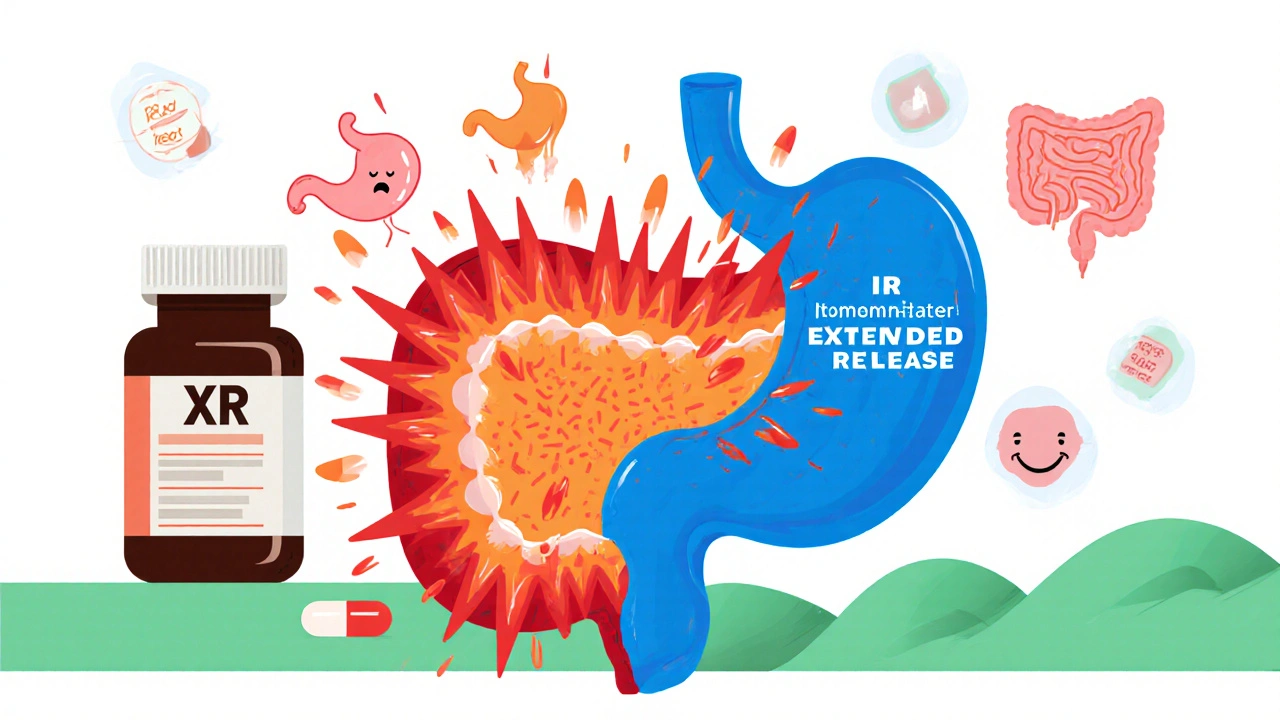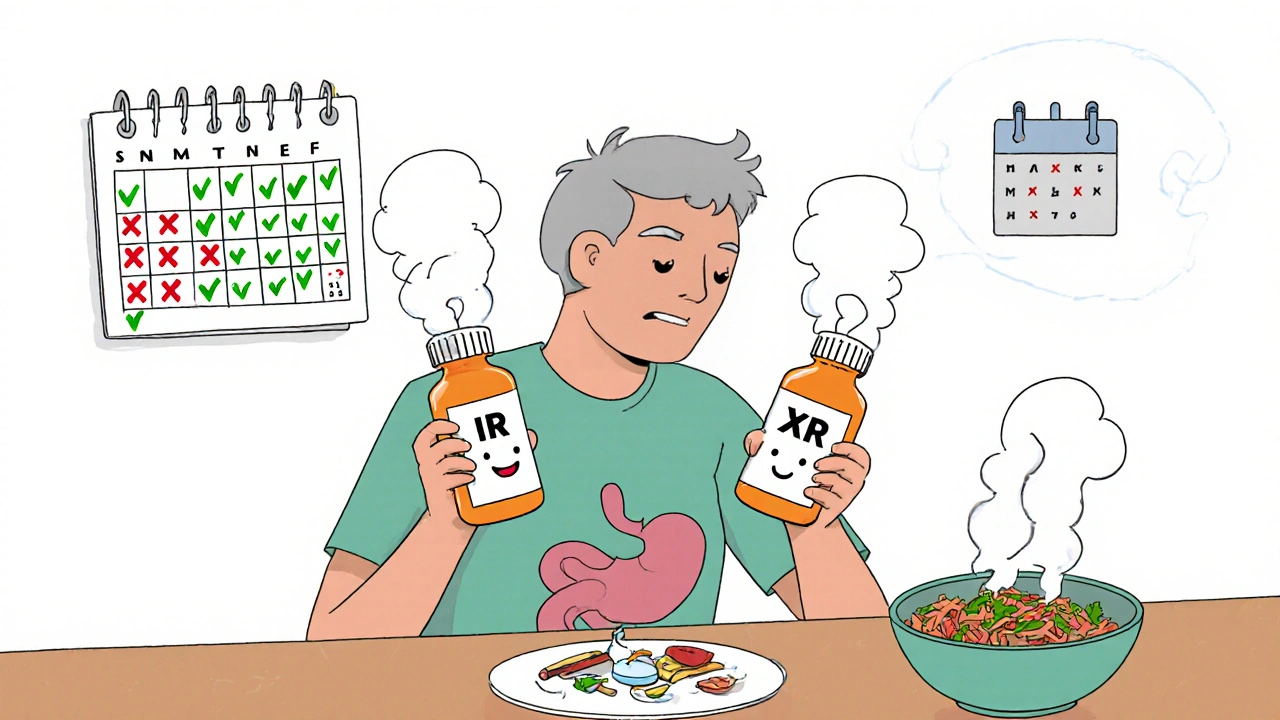Metformin Extended-Release vs Immediate-Release: Which Is Easier on Your Stomach?
 Nov, 17 2025
Nov, 17 2025
Metformin Side Effect Calculator
Recommendation
When you’re first prescribed metformin for type 2 diabetes, most doctors don’t warn you about the stomach issues. But if you’ve taken it, you know-diarrhea, nausea, bloating. It’s not just annoying; it’s enough to make people quit the drug altogether. And that’s a problem, because metformin is still the #1 first-line medication for diabetes worldwide. The good news? There’s a version that’s easier on your gut: extended-release (XR). But is it worth it? Let’s break down what actually changes when you switch from immediate-release (IR) to extended-release metformin-and what the data says about your stomach.
Why Your Stomach Reacts to Metformin
Metformin doesn’t get absorbed in your stomach. It’s absorbed in the upper part of your small intestine. But here’s the catch: the drug irritates the lining there, especially when a big dose hits all at once. That’s why immediate-release metformin causes so many GI problems. You take a 500 mg or 850 mg tablet, and within 2 to 3 hours, your gut gets blasted with a high concentration of the drug. That spike triggers nausea, cramping, and diarrhea in about 20-30% of users. For some, it’s mild. For others, it’s enough to stop taking it.How Extended-Release Metformin Works Differently
Extended-release metformin uses a special coating or gel system-like Glucophage XR’s GelShield Diffusion System-to slowly release the drug over 8 hours. Instead of one big blast, your body gets a steady trickle. That means the peak concentration in your blood is lower and comes later. A 2017 study showed that while IR hits peak levels in about 3 hours, XR takes 7 to 8 hours. The total amount of drug your body gets is about the same, but it’s spread out. This isn’t just theory. Real patients notice the difference. On the diabetes forum TuDiabetes, 68% of users who switched from IR to XR reported “noticeable improvement” in GI symptoms. One person wrote: “I went from daily diarrhea to maybe 1-2 days a month.” That’s not a fluke. A 2021 meta-analysis of nearly 2,400 patients found that XR cut overall GI side effects by 15.3% compared to IR. Diarrhea dropped from 28.6% to 17.5% in one major study. That’s a big deal when you’re trying to stick with a daily pill.But It’s Not Perfect-Nausea Can Get Worse
Here’s where things get tricky. While XR reduces diarrhea and cramping, some people report more nausea with the extended-release version. One study found nausea occurred in 4.6% of XR users versus 2.8% on IR. Why? No one’s completely sure. One theory is that the slower release keeps the drug in contact with the upper gut longer, which might irritate nerves tied to nausea. Another possibility is that people who switch from IR to XR are already sensitive, so even small changes feel bigger. A Reddit user named u/GlucophageProblems shared: “I switched to XR thinking it would help-but I started getting nauseous every morning. Went back to splitting my IR dose. Better results.” That’s not rare. About 8% of users in online forums actually felt worse after switching. So if you’ve tried XR and it made nausea worse, don’t assume it’s your fault. It’s not a one-size-fits-all solution.
What the Experts Say
The American Association of Clinical Endocrinologists (AACE) says XR is preferred over IR because of better tolerability. The UK’s NICE guidelines even recommend XR specifically for patients who can’t handle IR. But not everyone’s convinced. Dr. John Reinstatler, in a 2012 review, warned that the improvement might be “overstated,” especially since XR can cost 25-35% more. And the European Association for the Study of Diabetes agrees: the benefit is real, but “may not be clinically meaningful for all patients.” So what’s the real takeaway? If you’re struggling with diarrhea, bloating, or frequent bathroom trips on IR, switching to XR is a smart move. If your main issue is nausea and you’ve never had diarrhea, maybe stick with IR and try taking it with food or splitting the dose.Dosing Tips to Reduce Side Effects
No matter which version you take, how you start matters more than you think. A 2024 review found that starting at 500 mg once daily with your evening meal cuts initial GI side effects by 42% compared to jumping to higher doses. The American Diabetes Association’s 2023 guidelines say the same thing: start low, go slow. For XR: Take one 500 mg tablet with dinner. Wait a week. If you’re fine, go to 1,000 mg. Then 1,500 mg after another week. Most people reach 2,000 mg by week 4 or 5-and they rarely get sick. For IR: If you’re still on IR, split your dose. Instead of 1,000 mg at breakfast, take 500 mg at breakfast and 500 mg at dinner. That halves the shock to your gut. Many patients find this works better than switching to XR.Cost and Availability
Generic metformin IR costs about $8-$12 for a 30-day supply. Generic XR? $10-$15. That gap has narrowed since 2020, but it’s still there. Insurance often covers both, but some plans still make you try IR first. If your insurer denies XR, ask your doctor to write a letter explaining your GI issues. Many patients get approved after a simple appeal. In the U.S., XR now makes up nearly 59% of all metformin prescriptions-up from 42% in 2018. More doctors are choosing it because patients stick with it longer. A 2022 study of nearly 19,000 people found that those on XR stayed on their medication 2.1 months longer than those on IR. That’s not just about comfort-it’s about better blood sugar control over time.
What’s Next? New Formulations Coming
A new XR version called Metformax XR, approved by the FDA in 2023, uses pH-dependent release tech. Early data suggests it cuts GI side effects another 12-15% compared to existing XR. It’s not widely available yet, but it’s a sign that drugmakers are still working to make metformin easier to take. The MET-XR trial, tracking 1,200 patients over two years, will deliver more definitive results in mid-2024.Who Should Switch? Who Should Stay?
Switch to XR if:- You get diarrhea or cramps on IR
- You’ve tried splitting your IR dose and it didn’t help
- You’re struggling to stay on your medication because of stomach issues
- Your doctor recommends it based on your symptoms
- Your only issue is mild nausea (try taking it with food first)
- You’re cost-sensitive and IR works fine for you
- You’ve never had diarrhea or loose stools
- You prefer taking pills twice a day and can manage it
Final Thought: It’s About Sticking With It
Metformin works. It lowers blood sugar, reduces heart risks, and doesn’t cause weight gain or low blood sugar like some other diabetes drugs. But if your stomach won’t let you take it, it doesn’t matter how good it is. XR isn’t magic. It won’t fix everything. But for a lot of people, it’s the difference between quitting the drug and staying on it long-term. If you’ve been struggling with GI side effects, talk to your doctor about switching. Don’t suffer in silence-there’s a better way.Is extended-release metformin better for your stomach than immediate-release?
Yes, for most people who experience diarrhea, bloating, or cramping on immediate-release metformin. Studies show extended-release (XR) reduces overall gastrointestinal side effects by about 15%, especially diarrhea. It doesn’t eliminate side effects entirely, but it makes them milder and less frequent for the majority of users.
Does metformin XR cause more nausea than immediate-release?
Some people do report more nausea with XR. One study found nausea occurred in 4.6% of XR users versus 2.8% on IR. The reason isn’t fully understood, but it may be due to longer exposure of the upper gut to the drug. If nausea is your main issue, try splitting your IR dose with meals before switching.
How should I start metformin to avoid stomach problems?
Start with 500 mg once daily, taken with your evening meal. Wait one week, then increase by 500 mg each week until you reach your target dose. This slow start reduces initial side effects by up to 42%. Whether you’re on IR or XR, this method works.
Is metformin XR more expensive than immediate-release?
Yes, but the gap has narrowed. Generic metformin IR costs about $8-$12 for a 30-day supply. Generic XR costs $10-$15. Insurance often covers both, but some require you to try IR first. If your doctor says XR is medically necessary due to GI issues, you can usually get it approved.
Can I switch from metformin IR to XR on my own?
No. Always talk to your doctor before switching. The dose isn’t always a 1:1 swap. For example, 1,000 mg of IR might equal 1,000 mg of XR, but your doctor may adjust based on your symptoms and blood sugar. Never change your dose without medical advice.
How long does it take for metformin XR to start working?
Metformin XR starts lowering blood sugar in about 1-2 weeks, but it can take up to 4-6 weeks to reach full effect. The extended-release doesn’t change how well it works-it just changes how gently it enters your system. Stick with it, even if you don’t feel different right away.

Gabe Solack
November 18, 2025 AT 23:06Kristina Williams
November 19, 2025 AT 15:37Shilpi Tiwari
November 20, 2025 AT 03:50Christine Eslinger
November 22, 2025 AT 00:21Denny Sucipto
November 22, 2025 AT 16:24Holly Powell
November 24, 2025 AT 01:57Emanuel Jalba
November 24, 2025 AT 21:06Heidi R
November 26, 2025 AT 10:44Brenda Kuter
November 27, 2025 AT 21:06Shaun Barratt
November 29, 2025 AT 02:35Iska Ede
November 30, 2025 AT 22:04Gabriella Jayne Bosticco
December 1, 2025 AT 02:47Sarah Frey
December 2, 2025 AT 06:19Katelyn Sykes
December 3, 2025 AT 12:54